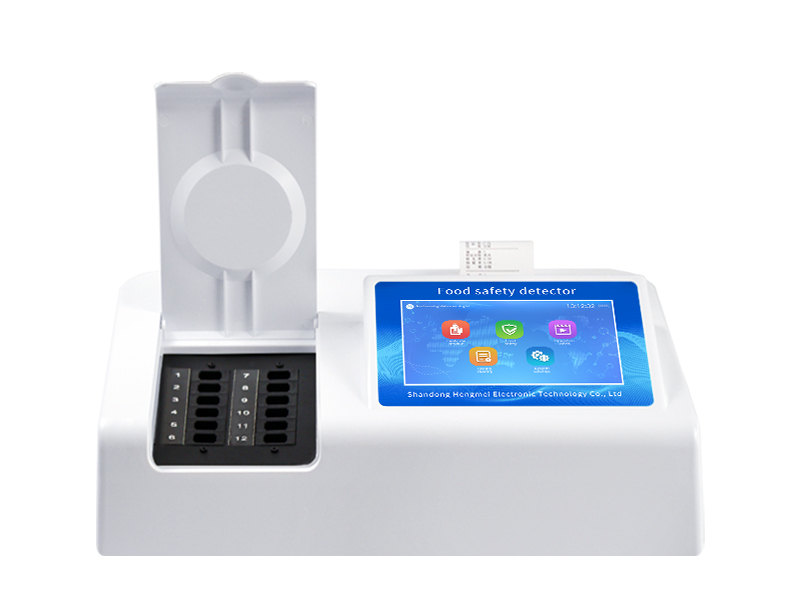As an important tool for food safety supervision, the multi parameter food safety detector provides strong technical support for the full chain supervision from farmland to dining table by quickly and accurately detecting various food safety indicators.
Multi parameter food safety detector is an integrated rapid detection and analysis equipment for food safety, which can simultaneously detect multiple indicators such as formaldehyde, sulfur dioxide, nitrite, pesticide residues, etc. This instrument adopts advanced optical detection technology and intelligent analysis system, with high detection accuracy and easy operation. It has been widely used in market supervision, food production, catering services and other aspects.

1.Working principle and technical characteristics of multi parameter food safety detector
1.1 Core detection principle
The multi parameter food safety detector is mainly based on the principle of spectrophotometry, which quantitatively analyzes target substances by measuring the absorbance changes of solutions at specific wavelengths. The working principle varies for different testing items:
Formaldehyde detection: Acetylacetone method is used. Formaldehyde reacts with acetylacetone under alkaline conditions to form a yellow compound, and the absorbance is measured at a wavelength of 412nm.
Sulfur dioxide detection: Based on the secondary magenta method, sulfur dioxide reacts with secondary magenta to produce a purple red compound, which is measured at a wavelength of 550nm.
Nitrite detection: Using the Grignard reagent method, nitrite reacts with p-aminobenzenesulfonic acid to generate azo dyes, which are measured at a wavelength of 540nm.
Pesticide residue detection: Through enzyme inhibition rate method, organophosphate and carbamate pesticides inhibit cholinesterase activity and affect color reaction.
The instrument adopts a four wavelength cold light source system (410, 520, 590, 630nm), combined with patented optical path switching technology, which can achieve accurate measurement of 64 wavelengths and meet the needs of different detection projects.
1.2 Analysis of Instrument Technical Parameters
The multi parameter food safety detector has the following core performance indicators:
Detection efficiency: ≥ 12 detection channels, capable of detecting multiple samples simultaneously
Optical system: Four wavelength cold light source, automatic calibration of light intensity
Data processing: ARM Cortex-A7 quad core processor, with a clock speed of 1.88GHz
Data storage: 200000 test results, supporting USB drive export
Portable performance: Weighing only 3.6kg, supporting car power supply
Communication function: Supports multiple data transmission methods such as WiFi, GPRS, Ethernet, etc
1.3 Instrument Structure and Functional Characteristics
Modern multi parameter food safety detectors have multiple innovations in design and functionality:
Intelligent detection system: 12 channel independent detection design; Four wavelength cold light source system; Automatic calibration function
Data management system: supports multiple data transmission methods; Docking with the food safety supervision platform; Large capacity data storage
User friendly design: 8-inch touch screen operation; Built in detection method library; Switching between Chinese and English interfaces
Portable performance: Lightweight design (3.6kg); AC/DC power supply; Car power adapter
Extension function: The detection items are expandable; Remote firmware upgrade; Printing QR code report
2.Technical advantages and application value of multi parameter food safety detection instrument
2.1 Analysis of Technical Advantages
Compared with traditional detection methods, multi parameter food safety detectors have significant advantages:
Efficient detection: The 12 channel design can simultaneously detect multiple samples, and the daily detection volume of a certain market regulatory agency has increased from 30 to 150 samples.
Accurate and reliable: The four wavelength optical system, combined with intelligent algorithms, achieves a consistency of over 95% between the detection results and laboratory methods.
Intelligent and convenient: Touchscreen guided operation, beginners can independently complete the detection after simple training, and a school cafeteria employee can start working after 2 hours of training.
Data traceability: The detection data is automatically uploaded to the regulatory platform, supporting long-term storage and analysis. A certain chain supermarket has established a 3-year food safety database.
Economical and practical: Integrated design reduces testing costs, resulting in an annual savings of approximately 200000 yuan for a certain testing institution.
2.2 Application Value Reflection
Multi parameter food safety detectors play an important role in multiple fields:
Market supervision: On site rapid inspections were conducted in agricultural markets, supermarkets, and other places. A certain district completed 100000 batches of rapid inspections throughout the year, and the problem detection rate increased threefold.
Food production: Raw materials entering the factory and finished products leaving the factory are inspected. The pass rate of product sampling in a certain food factory has increased from 92% to 98%.
Catering services: Food inspection by schools, hotels and other catering units has increased the qualification rate of ingredients in a university cafeteria to 99.5%.
Agricultural production: Self inspection of agricultural product production areas shows that the rate of excessive pesticide residues in products from a certain vegetable base has decreased by 80%.
Emergency detection: Rapid screening of food safety incidents, identifying problematic ingredients within 2 hours of a food poisoning incident.
Address of this article:http://www.hmfoodtesting.com/article/162.html


 Current
location:
Current
location:





